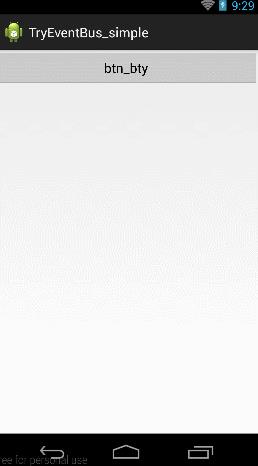EventBus使用详解
Posted 叉腰大眼仔
tags:
篇首语:本文由小常识网(cha138.com)小编为大家整理,主要介绍了EventBus使用详解相关的知识,希望对你有一定的参考价值。
前言:EventBus是上周项目中用到的,网上的文章大都一样,或者过时,有用的没几篇,经过琢磨,请教他人,也终于弄清楚点眉目,记录下来分享给大家。
相关文章:
1、《EventBus使用详解(一)——初步使用EventBus》
2、《EventBus使用详解(二)——EventBus使用进阶》
一、概述
EventBus是一款针对android优化的发布/订阅事件总线。主要功能是替代Intent,Handler,BroadCast在Fragment,Activity,Service,线程之间传递消息.优点是开销小,代码更优雅。以及将发送者和接收者解耦。
1、下载EventBus的类库
源码:https://github.com/greenrobot/EventBus
2、基本使用
(1)自定义一个类,可以是空类,比如:
[java] view plain copy


- public class AnyEventType
- public AnyEventType()
(2)在要接收消息的页面注册:
[java] view plain copy


- eventBus.register(this);
(3)发送消息
[java] view plain copy


- eventBus.post(new AnyEventType event);
(4)接受消息的页面实现(共有四个函数,各功能不同,这是其中之一,可以选择性的实现,这里先实现一个):
[java] view plain copy


- public void onEvent(AnyEventType event)
[java] view plain copy


- eventBus.unregister(this);
首先,在EventBus中,获取实例的方法一般是采用EventBus.getInstance()来获取默认的EventBus实例,当然你也可以new一个又一个,个人感觉还是用默认的比较好,以防出错。
二、实战
先给大家看个例子:
当击btn_try按钮的时候,跳到第二个Activity,当点击第二个activity上面的First Event按钮的时候向第一个Activity发送消息,当第一个Activity收到消息后,一方面将消息Toast显示,一方面放入textView中显示。

按照下面的步骤,下面来建这个工程:
1、基本框架搭建
想必大家从一个Activity跳转到第二个Activity的程序应该都会写,这里先稍稍把两个Activity跳转的代码建起来。后面再添加EventBus相关的玩意。
MainActivity布局(activity_main.xml)
[html] view plain copy


- <LinearLayout xmlns:android="http://schemas.android.com/apk/res/android"
- xmlns:tools="http://schemas.android.com/tools"
- android:layout_width="match_parent"
- android:layout_height="match_parent"
- android:orientation="vertical">
- <Button
- android:id="@+id/btn_try"
- android:layout_width="match_parent"
- android:layout_height="wrap_content"
- android:text="btn_bty"/>
- <TextView
- android:id="@+id/tv"
- android:layout_width="wrap_content"
- android:layout_height="match_parent"/>
- </LinearLayout>
[html] view plain copy


- <LinearLayout xmlns:android="http://schemas.android.com/apk/res/android"
- xmlns:tools="http://schemas.android.com/tools"
- android:layout_width="match_parent"
- android:layout_height="match_parent"
- android:orientation="vertical"
- tools:context="com.harvic.try_eventbus_1.SecondActivity" >
- <Button
- android:id="@+id/btn_first_event"
- android:layout_width="match_parent"
- android:layout_height="wrap_content"
- android:text="First Event"/>
- </LinearLayout>
[java] view plain copy


- public class MainActivity extends Activity
- Button btn;
- @Override
- protected void onCreate(Bundle savedInstanceState)
- super.onCreate(savedInstanceState);
- setContentView(R.layout.activity_main);
- btn = (Button) findViewById(R.id.btn_try);
- btn.setOnClickListener(new View.OnClickListener()
- @Override
- public void onClick(View v)
- // TODO Auto-generated method stub
- Intent intent = new Intent(getApplicationContext(),
- SecondActivity.class);
- startActivity(intent);
- );
- EventBus使用详解——初步使用EventBus